Clark Youth Shooting Camp: Passing On The Heritage
By Pete Weisbrod
So finally after years of overseas deployments as both a special operations soldier and a contractor, I finally decided to settle down in rural South Dakota. I live in the county seat, so I live in a "big town" of about 1200. We have about 400 kids in the whole school system Pre-K to 12th grade. The town of Clark sets in eastern South Dakota smack dab in the middle of the prairie.

Hunting, however, is a big deal here. Pheasants of course are the biggest deal as hunters flock from all over the country to hunt. But for the locals the quest for whitetails is huge, as well as heading out to the western side of the state to hunt for speed goats (which is considered an excused absence at school). The wide open country is a long range shooter's dream, not including the ever present wind.
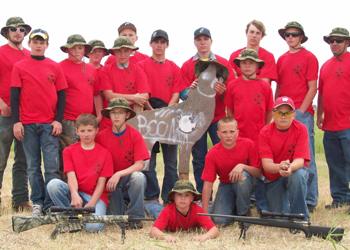
In a small town it doesn't take long for news to travel. So it didn't take long for the fact to get out that I hoped one day to get a few of our teenager hunters out to learn a few things. Apparently that planted a seed, because my words eventually came full circle. Several dads asked that I run a youth shooting course. Of course they didn't really have to twist my arm too hard, and the Clark County Youth Shooting Camp was born.
My initial intention was to have the boys show up with the rifle they intended to hunt with the following fall. When they were finished the younger kids would be shooting out to 400 yards, and the older and more advanced shooters out to 600. In South Dakota the youth hunting ages are from 12 – 17, so I stuck with those ages. I decided 20 kids was as many as I could handle, figuring they would be shooting in pairs, meaning only ten shooters at once.
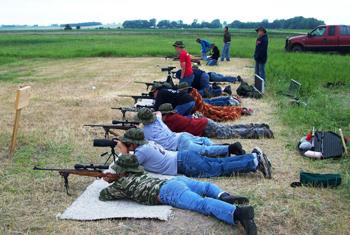
I thought I would need a full five days to cover all of the material I felt was pertinent. I put together a lesson plan that I thought made sense and identified the resources I would need. Anyone who has attended any shooting school understands how expensive it can be. Since this was for kids I knew that I was working with a shoestring budget. Having the kids shoot 250 rounds a gun was expensive enough. So off I went chasing sponsors for everything from the land to shoot on, cleaning supplies, ammo, bipods, wind meters, lumber, steel targets, shooting sticks, spray glue, spray paint, ear protection and a classroom. You name it and I pretty much needed it, including assistant instructors. I made it very clear I did not want money, nor was I making a single dime. I just wanted the supplies needed to put on a first rate camp for the kids and still make it affordable enough that kids in a rural community could attend. Some sponsors were local businesses and some were larger companies nationwide. Some I visited in person and some I simply emailed, but almost without exception the result was the same… I received something!!!! It may have been a price break on shipping, a substantial discount or an out and out donation or just good advice. God, I love this country!
Once I had a rough plan on paper and wrote up the classes, I sent them to friends both on LongRangeHunting.com as well as other snipers and sniper instructors for a sanity check. I was even lucky enough to get advice from a LRH member who had just finished the 4-H range masters course. Since I was now dealing with kids and not steely eyed killers I knew I would have to adjust a few things.
At this point I had a pretty feasible plan, so I went and rounded up the kids to fill the 20 slots. As I am sure you can imagine it didn't take long! When I would speak to the dads about it I was often asked if they could leave the boy at home and come themselves! I received only one "no" and that was because the young man had a job that wouldn't allow it.
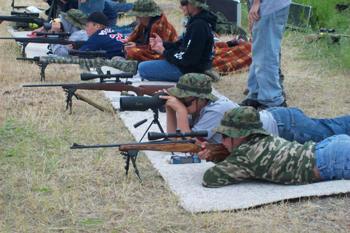
Despite having awesome sponsors, rounding up all the resources was no simple task. Particularly with the finance department (my lovely wife) looking over my shoulder. Based on the weather we had this spring, finding ground to use as a suitable 600-800 yard range was more challenging than expected, despite being on the prairie. Even though I started putting this together just before Christmas, mid-May found me scrambling to be ready for the second week of June camp. I must admit that I think I was more excited than the boys were, though many fathers and boys tried to tell me otherwise.
The week prior to camp starting was comprised of 8 – 10 hours days filling sand bags, printing out drops charts, building target frames, cutting out field targets and finalizing classes. Bill Makkens and Brian Anderson of Oak Tree Lodge came through with flying colors by providing the real estate for the range. Setting up and verifying the range out of a large pasture with knee high grass was challenging to say the least. But thank goodness for the last minute when it all came together. The night before camp was due to start my wife told me, "You better have your stuff together or we will never hear the end of it". I fully understand the devil is in the details and that Murphy is alive and well. But felt I had all my bases covered.
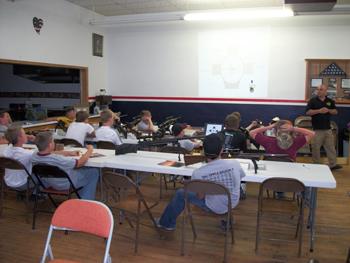
Day 1: We began at the local American Legion Hall with classes on safety, range conduct, weapons familiarization and sight adjustments. We did practical exercises in the prone shooting position; dry firing with bipod and buttsock (tube sock filled with rice). Just prior to heading to the range I gave a class on weapons cleaning and had the kids clean their rifles. I just saw it as one more safety check to ensure we didn't have something packed in a barrel. Then we packed up and headed to the range where we began by shooting scoped .22 rifles at steel plates at 50 yards. After several coats of white spray paint and about 100 rounds per kid, most of the boys where banging out inch sized groups and lots of bragging rights. We then moved on to the 25 yard zero with their hunting rifles, which went surprisingly well. I have learned that classroom time is boring to kids no matter what the subject. At least until I started into the minutes of angle and mil subjects. But most importantly, all that kids really want to do is shoot. I had been a little worried that the kids might not enjoy the course or the long days, so I was quite happy that evening to receive a half dozen phone calls from parents telling me that the kids had a blast.
Day 2: We began with external ballistics and wind doping classes and continued on the range with zeroing and data development from 100-300 yards. Winds were 15 – 22 mph that begun at 12 o'clock and shifted to 4 o'clock. So the kids certainly got a crash course in shooting in South Dakota winds. I had planned to make it to 400 yards but we just didn't make it that far.
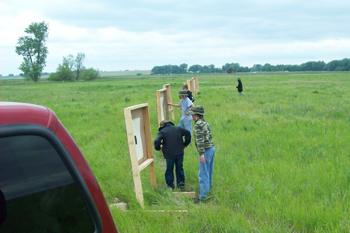
Day 3: We started at 200 and reconfirming our zeros then moved to 300 yards confirming data and doing grouping drills. Winds again were gusting to 28 mph so we spent extra time here. Oak Tree Lodge put on a huge spread for lunch. This included a tour of countless full mounts of waterfowl from both North and South America, sheep, elk, bear, deer, moose, antelope and other assorted critters complete with stories from the "old timer" who had harvested them. Oak Tree Lodge also has world class dogs so no tour would have been complete without a "dog show" culminating in all the boys working with the animals. After dinner and a show we finally reached 400 yards and began getting our initial data. This is where things got quite challenging for kids using Kentucky windage versus dialing in their range. Some kids were making pretty good wind calls at this point. We finished shooting about 3:30 and headed back to the classroom. With around 100 rounds through each gun we finished out day with some well needed weapo
Day 4: We started with 400 and beyond for older kids and field shooting positions at known distances 50 - 300 yards for younger kids. Field positions consisted of standing off hand, kneeling, sitting all with and without shooting sticks, back packs, tripods and fence posts. However, once the older boys had shout their strings and where waiting to go look at their targets they had fun shooting the bolts that held the steel gongs to the plywood animals. But by golly they were doing a good job of it in those winds, so I decided to just egg them on instead of chewing them out for messing up my targets. This seemed like a free for all to the kids after the tedious paper shooting. Let's face it, we all love to heard that steel sing!
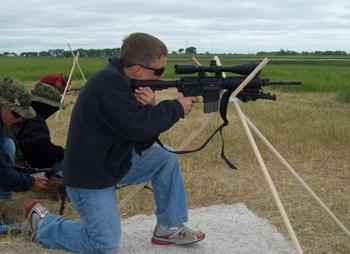
Day 5: We finally had little to no wind, so the gongs where ringing loud and clear out to 500 yards. I spread out my field targets at random from 75 to 350 yards and a few 12 X 12 steel plates out to 500 yards. The kids again shot from field positions but I did let them squeak in some of the long shots from their Sun Optics USA bipods. This was just a half day of field shooting about 40 rounds per gun. We finished shooting at 11:00 so the next 2 hours was clean up of both the range and the classroom. So at 1 o'clock I bid farewell to "my boys". I received many thanks from kids and parents alike, but the pleasure was all mine.

Parting shot: I spent probably 300 hours preparing for and running this camp. Some of it did not go as planned. I was not able to get as technical in certain aspects as I had thought, but I had twice as much fun and even learned some new teenager lingo. I felt very satisfied that I was able to pass on a small piece of America's hunting and shooting heritage as it was once done for me. But most importantly we were safe, had fun and the kids still learned quite a bit. Isn't that what camp is all about?
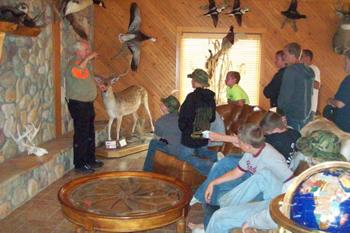
A big thank you to our Clark Youth Shooting Camp Sponsors:
Oak Tree Lodge: This is a world class pheasant and waterfowl outfitter and lodge that donated the use of the land used as the range. As well as provided assistance in teaching.
Midway USA: Discounted prices on cleaning supplies and ammunition.
P-4 Manufacturing: Donated the "pimp" safety glasses and constructed the target frames and field targets.
Texas Defensive Shooting Academy: Provided advice and insight.
American Legion Post 60: Donated their building for use as the classroom and staging area in town.
Dekker's Hardware: Donated spray paint and materials used in target construction.
Sun Optics USA: Donated bipods for all shooters.
Pro-Build: Donated all the lumber needed to construct the target frames.
Caldwell: Donated two Wind Wizards used on the firing line to help the kids with wind calls
.
LongrangeHunting.com: Len allowed me to modify his logo and use it as ours and most importantly allowing me to tell the story of the kids I'm quite proud of.
Quality Targets: Provided the AR-500 steel gongs.
Pete Weisbrod is a retired Special Forces soldier, sniper and Master Class shooter in IDPA and avid hunter of all game in North America.
By Pete Weisbrod
So finally after years of overseas deployments as both a special operations soldier and a contractor, I finally decided to settle down in rural South Dakota. I live in the county seat, so I live in a "big town" of about 1200. We have about 400 kids in the whole school system Pre-K to 12th grade. The town of Clark sets in eastern South Dakota smack dab in the middle of the prairie.

Hunting, however, is a big deal here. Pheasants of course are the biggest deal as hunters flock from all over the country to hunt. But for the locals the quest for whitetails is huge, as well as heading out to the western side of the state to hunt for speed goats (which is considered an excused absence at school). The wide open country is a long range shooter's dream, not including the ever present wind.

In a small town it doesn't take long for news to travel. So it didn't take long for the fact to get out that I hoped one day to get a few of our teenager hunters out to learn a few things. Apparently that planted a seed, because my words eventually came full circle. Several dads asked that I run a youth shooting course. Of course they didn't really have to twist my arm too hard, and the Clark County Youth Shooting Camp was born.
My initial intention was to have the boys show up with the rifle they intended to hunt with the following fall. When they were finished the younger kids would be shooting out to 400 yards, and the older and more advanced shooters out to 600. In South Dakota the youth hunting ages are from 12 – 17, so I stuck with those ages. I decided 20 kids was as many as I could handle, figuring they would be shooting in pairs, meaning only ten shooters at once.

I thought I would need a full five days to cover all of the material I felt was pertinent. I put together a lesson plan that I thought made sense and identified the resources I would need. Anyone who has attended any shooting school understands how expensive it can be. Since this was for kids I knew that I was working with a shoestring budget. Having the kids shoot 250 rounds a gun was expensive enough. So off I went chasing sponsors for everything from the land to shoot on, cleaning supplies, ammo, bipods, wind meters, lumber, steel targets, shooting sticks, spray glue, spray paint, ear protection and a classroom. You name it and I pretty much needed it, including assistant instructors. I made it very clear I did not want money, nor was I making a single dime. I just wanted the supplies needed to put on a first rate camp for the kids and still make it affordable enough that kids in a rural community could attend. Some sponsors were local businesses and some were larger companies nationwide. Some I visited in person and some I simply emailed, but almost without exception the result was the same… I received something!!!! It may have been a price break on shipping, a substantial discount or an out and out donation or just good advice. God, I love this country!
Once I had a rough plan on paper and wrote up the classes, I sent them to friends both on LongRangeHunting.com as well as other snipers and sniper instructors for a sanity check. I was even lucky enough to get advice from a LRH member who had just finished the 4-H range masters course. Since I was now dealing with kids and not steely eyed killers I knew I would have to adjust a few things.
At this point I had a pretty feasible plan, so I went and rounded up the kids to fill the 20 slots. As I am sure you can imagine it didn't take long! When I would speak to the dads about it I was often asked if they could leave the boy at home and come themselves! I received only one "no" and that was because the young man had a job that wouldn't allow it.

Despite having awesome sponsors, rounding up all the resources was no simple task. Particularly with the finance department (my lovely wife) looking over my shoulder. Based on the weather we had this spring, finding ground to use as a suitable 600-800 yard range was more challenging than expected, despite being on the prairie. Even though I started putting this together just before Christmas, mid-May found me scrambling to be ready for the second week of June camp. I must admit that I think I was more excited than the boys were, though many fathers and boys tried to tell me otherwise.
The week prior to camp starting was comprised of 8 – 10 hours days filling sand bags, printing out drops charts, building target frames, cutting out field targets and finalizing classes. Bill Makkens and Brian Anderson of Oak Tree Lodge came through with flying colors by providing the real estate for the range. Setting up and verifying the range out of a large pasture with knee high grass was challenging to say the least. But thank goodness for the last minute when it all came together. The night before camp was due to start my wife told me, "You better have your stuff together or we will never hear the end of it". I fully understand the devil is in the details and that Murphy is alive and well. But felt I had all my bases covered.

Day 1: We began at the local American Legion Hall with classes on safety, range conduct, weapons familiarization and sight adjustments. We did practical exercises in the prone shooting position; dry firing with bipod and buttsock (tube sock filled with rice). Just prior to heading to the range I gave a class on weapons cleaning and had the kids clean their rifles. I just saw it as one more safety check to ensure we didn't have something packed in a barrel. Then we packed up and headed to the range where we began by shooting scoped .22 rifles at steel plates at 50 yards. After several coats of white spray paint and about 100 rounds per kid, most of the boys where banging out inch sized groups and lots of bragging rights. We then moved on to the 25 yard zero with their hunting rifles, which went surprisingly well. I have learned that classroom time is boring to kids no matter what the subject. At least until I started into the minutes of angle and mil subjects. But most importantly, all that kids really want to do is shoot. I had been a little worried that the kids might not enjoy the course or the long days, so I was quite happy that evening to receive a half dozen phone calls from parents telling me that the kids had a blast.
Day 2: We began with external ballistics and wind doping classes and continued on the range with zeroing and data development from 100-300 yards. Winds were 15 – 22 mph that begun at 12 o'clock and shifted to 4 o'clock. So the kids certainly got a crash course in shooting in South Dakota winds. I had planned to make it to 400 yards but we just didn't make it that far.

Day 3: We started at 200 and reconfirming our zeros then moved to 300 yards confirming data and doing grouping drills. Winds again were gusting to 28 mph so we spent extra time here. Oak Tree Lodge put on a huge spread for lunch. This included a tour of countless full mounts of waterfowl from both North and South America, sheep, elk, bear, deer, moose, antelope and other assorted critters complete with stories from the "old timer" who had harvested them. Oak Tree Lodge also has world class dogs so no tour would have been complete without a "dog show" culminating in all the boys working with the animals. After dinner and a show we finally reached 400 yards and began getting our initial data. This is where things got quite challenging for kids using Kentucky windage versus dialing in their range. Some kids were making pretty good wind calls at this point. We finished shooting about 3:30 and headed back to the classroom. With around 100 rounds through each gun we finished out day with some well needed weapo
Day 4: We started with 400 and beyond for older kids and field shooting positions at known distances 50 - 300 yards for younger kids. Field positions consisted of standing off hand, kneeling, sitting all with and without shooting sticks, back packs, tripods and fence posts. However, once the older boys had shout their strings and where waiting to go look at their targets they had fun shooting the bolts that held the steel gongs to the plywood animals. But by golly they were doing a good job of it in those winds, so I decided to just egg them on instead of chewing them out for messing up my targets. This seemed like a free for all to the kids after the tedious paper shooting. Let's face it, we all love to heard that steel sing!

Day 5: We finally had little to no wind, so the gongs where ringing loud and clear out to 500 yards. I spread out my field targets at random from 75 to 350 yards and a few 12 X 12 steel plates out to 500 yards. The kids again shot from field positions but I did let them squeak in some of the long shots from their Sun Optics USA bipods. This was just a half day of field shooting about 40 rounds per gun. We finished shooting at 11:00 so the next 2 hours was clean up of both the range and the classroom. So at 1 o'clock I bid farewell to "my boys". I received many thanks from kids and parents alike, but the pleasure was all mine.

Parting shot: I spent probably 300 hours preparing for and running this camp. Some of it did not go as planned. I was not able to get as technical in certain aspects as I had thought, but I had twice as much fun and even learned some new teenager lingo. I felt very satisfied that I was able to pass on a small piece of America's hunting and shooting heritage as it was once done for me. But most importantly we were safe, had fun and the kids still learned quite a bit. Isn't that what camp is all about?

A big thank you to our Clark Youth Shooting Camp Sponsors:
Oak Tree Lodge: This is a world class pheasant and waterfowl outfitter and lodge that donated the use of the land used as the range. As well as provided assistance in teaching.
Midway USA: Discounted prices on cleaning supplies and ammunition.
P-4 Manufacturing: Donated the "pimp" safety glasses and constructed the target frames and field targets.
Texas Defensive Shooting Academy: Provided advice and insight.
American Legion Post 60: Donated their building for use as the classroom and staging area in town.
Dekker's Hardware: Donated spray paint and materials used in target construction.
Sun Optics USA: Donated bipods for all shooters.
Pro-Build: Donated all the lumber needed to construct the target frames.
Caldwell: Donated two Wind Wizards used on the firing line to help the kids with wind calls
.
LongrangeHunting.com: Len allowed me to modify his logo and use it as ours and most importantly allowing me to tell the story of the kids I'm quite proud of.
Quality Targets: Provided the AR-500 steel gongs.
Pete Weisbrod is a retired Special Forces soldier, sniper and Master Class shooter in IDPA and avid hunter of all game in North America.

